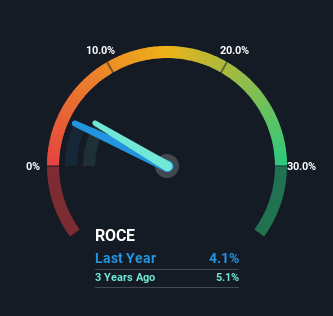- United Kingdom
- /
- Oil and Gas
- /
- AIM:INDI
Indus Gas (LON:INDI) Might Be Having Difficulty Using Its Capital Effectively

Did you know there are some financial metrics that can provide clues of a potential multi-bagger? Typically, we'll want to notice a trend of growing return on capital employed (ROCE) and alongside that, an expanding base of capital employed. This shows us that it's a compounding machine, able to continually reinvest its earnings back into the business and generate higher returns. In light of that, when we looked at Indus Gas (LON:INDI) and its ROCE trend, we weren't exactly thrilled.
Understanding Return On Capital Employed (ROCE)
If you haven't worked with ROCE before, it measures the 'return' (pre-tax profit) a company generates from capital employed in its business. To calculate this metric for Indus Gas, this is the formula:
Return on Capital Employed = Earnings Before Interest and Tax (EBIT) ÷ (Total Assets - Current Liabilities)
0.041 = US$55m ÷ (US$1.4b - US$31m) (Based on the trailing twelve months to March 2023).
Thus, Indus Gas has an ROCE of 4.1%. In absolute terms, that's a low return and it also under-performs the Oil and Gas industry average of 11%.
Check out our latest analysis for Indus Gas

While the past is not representative of the future, it can be helpful to know how a company has performed historically, which is why we have this chart above. If you'd like to look at how Indus Gas has performed in the past in other metrics, you can view this free graph of past earnings, revenue and cash flow.
What Does the ROCE Trend For Indus Gas Tell Us?
On the surface, the trend of ROCE at Indus Gas doesn't inspire confidence. Around five years ago the returns on capital were 6.8%, but since then they've fallen to 4.1%. However, given capital employed and revenue have both increased it appears that the business is currently pursuing growth, at the consequence of short term returns. And if the increased capital generates additional returns, the business, and thus shareholders, will benefit in the long run.
The Bottom Line On Indus Gas' ROCE
While returns have fallen for Indus Gas in recent times, we're encouraged to see that sales are growing and that the business is reinvesting in its operations. And there could be an opportunity here if other metrics look good too, because the stock has declined 61% in the last five years. So we think it'd be worthwhile to look further into this stock given the trends look encouraging.
Like most companies, Indus Gas does come with some risks, and we've found 2 warning signs that you should be aware of.
While Indus Gas isn't earning the highest return, check out this free list of companies that are earning high returns on equity with solid balance sheets.
New: AI Stock Screener & Alerts
Our new AI Stock Screener scans the market every day to uncover opportunities.
• Dividend Powerhouses (3%+ Yield)
• Undervalued Small Caps with Insider Buying
• High growth Tech and AI Companies
Or build your own from over 50 metrics.
Have feedback on this article? Concerned about the content? Get in touch with us directly. Alternatively, email editorial-team (at) simplywallst.com.
This article by Simply Wall St is general in nature. We provide commentary based on historical data and analyst forecasts only using an unbiased methodology and our articles are not intended to be financial advice. It does not constitute a recommendation to buy or sell any stock, and does not take account of your objectives, or your financial situation. We aim to bring you long-term focused analysis driven by fundamental data. Note that our analysis may not factor in the latest price-sensitive company announcements or qualitative material. Simply Wall St has no position in any stocks mentioned.
About AIM:INDI
Indus Gas
Through its subsidiaries, engages in the exploration, development, and production of oil and gas in Asia.
Good value slight.
Similar Companies
Market Insights
Community Narratives



